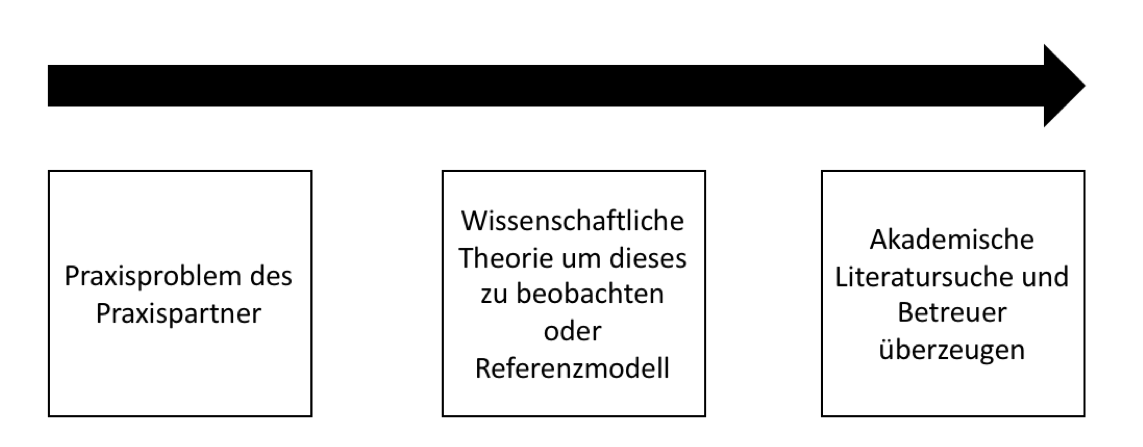Many of you are writing your thesis in collaboration with a company. I also have my master’s thesis agile in the Waterfallworld written with a company. Here the topic should often be very practical and a problem for the company, but at the same time also very academic. The solution of a company-specific problem such as the introduction of a SAP in a medium-sized SME, however, is not a sufficient bachelor thesis in a strictly academic sense. By the way, if you don’t have a topic at all, please read on with my topic-finding article.
Reading tip: Find topic
“The subject is too practical or too theoretical!”
So you are faced with the dilemma that the chair leans on the topic as too vague and the practice partner leans on the topic as too theoretical? For something like this, count on a coordination effort of 3 months. But it is worthwhile, as you are often employed directly afterwards and get good money while doing your thesis. In addition to the starting salary, my time as a junior consultant has also been significantly shortened.
The best way to do this is to look at what the company wants first. In 99% of the cases you will get a practical problem. Great examples are: How do we establish System XY, how do we get more skilled workers or how do we increase agility. When you have this, see if you can either design a reference model from the topic or examine the practical problem with a theory.
Tip: You can find an example of a literature analysis with many suggested topics for a thesis in my study from 2019 (online from March 2019).
Lindner, D., & Leyh, C .. (2019). Digitization of SMEs – questions, recommendations for action and implications for IT organization and IT service management. HMD – Praxis der Wirtschaftsinformatik , 4th , 21.
Roughly collect some literature and use this information to approach the supervisor at the chair. Below I explain how you can implement the intermediate step (reference model and theory). It is of course clear that you will have to do more loops and play a little ping pong between the practice partner and the supervisor. It took me 3 months back then. You have probably already tried a few things, otherwise you would not be reading this article. Many of you will not find any literature either. I wrote a separate article on this.
Reading tip: Help, I can’t find any literature!

Variant 1: reference modeling
“Reference modeling methods are used to create simplified representations of reality. Starting from observations (inductive) or derived from theories (deductive), these models are designed to represent a planned or optimized system environment.”(Bodendorf et al. 2012)
In this case, take the company’s practical problem and build a model or framework from it. For example, I did that too. For me it was a model for combining agile and waterfall-like methods.
A possible title for a work with a reference model would then be: A success factor model for the introduction of SAP systems or another example: Conception of an organizational framework for the establishment of Scrum in an SME. The problem is that not every supervisor likes the conception of a framework and it can be argued about how academic it is. But it is worth a try and it is usually of some use to the practice partner.
Reading tip: Reference modeling
Variant 2: Observation of the problem with theory
If the reference model does not work, then take a practical problem of the company and examine it with a theory such as game theory, agility, Porter’s Five Forces or similar. So you are investigating a problem in the company using a scientific theory. This forms the perfect bridge between theory and practice. You have to look for yourself and individually to see which theory can fit here. The following is a list of known theories that make sense in the course of our topic:
- Systems theory
- Taylorism / Scientific Management (Taylor)
- Theory X and Y (McGregor)
- Organizational life cycle models
- Organizational Development (Lewin)
- Evolutionary Management (St. Gallen)
- Incentive contribution theory (Simon / March / Banard)
- Further theories at the Management Academy
Special case: examine a specific context!
You only find general literature and nothing for your context, e.g. agility in clubs or agility in production? Then read my article which will specifically help you with this problem:
Reading tip: Find literature for practice partners
Conclusion: stay tuned and follow tips!
Many of you would like to write a thesis with a practice partner. Which is often useful as it makes it easier to start your career. However, this is also associated with 50% more effort than classic work at the chair. Therefore try to convince the chair with a theory or reference modeling.
- Reading tip: Tips for your thesis
- Reading tip: Development of a research design
Bodendorf, F., Löffler, C., & Hofmann, J. (2010). Research methods in business informatics. Business Informatics, (1), 1–44.



